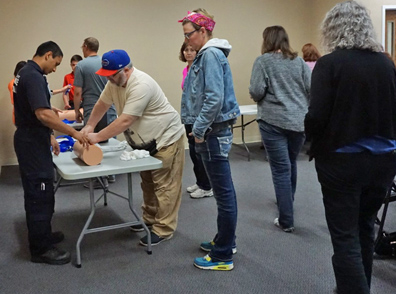By Heather Michon, correspondent
At the start of a talk hosted by the Fluvanna County Sheriff’s Office on Wednesday night (April 25), EMT Kyle Alexander warned the audience that he was about to show some graphic photos. “So if anyone feels faint,” he encouraged, “it’s okay to step out into the hall.”
Fortunately, the two dozen participants assembled at the Fluvanna Library resource room remained upright through the hour-long presentation led by Alexander, fellow Charlottesville Albemarle EMT Vikram Gupta, and staff from the University of Virginia Medical Center.
“Stop the Bleed” is a nationwide program that evolved out of a set of initiatives developed after the Sandy Hook school shooting in 2012.
With mass casualty events on the rise, the goal of “Stop the Bleed” is to train citizens to be “immediate responders,” able to give aid to victims before first responders arrive at the scene.
Liz Cochran, injury prevention coordinator at U.Va. Medical Center, said they’ve been presenting the free program to groups and private classes around Charlottesville and were working their way out to the wider region.
Life-threatening bleeding, be it from a mass shooting, a car accident, or an accident in the home or workplace, can kill a victim in three to five minutes.
“I don’t live out here,” said Gupta, “but I presume it takes more than five minutes to get EMTs to you.”
Rapid action can make the difference between life and death for thousands of Americans each year.
The instructors touched on the “ABC’s of bleeding control: Alert emergency responders, identify the source of the bleeding, and compress the wound using direct pressure, wound packing, or a tourniquet.
Participants took turns applying tourniquets to each others’ arms and legs and practiced wound packing and direct pressure on simulated wounds.
In the confines of a quiet conference room, absent real blood and conscious victims, it seems straightforward, but instructors warn that in the field, it’s an intense process.
Tourniquets, for example, are painful, but “that doesn’t mean you’re doing it wrong,” said Alexander. Direct pressure, where the responder puts all their weight on the wound, can also cause severe pain.
Once a bleeding control treatment is applied, “do not let go until you are relieved by emergency responders,” Gupta added.
The also recommended that people forget previous first-aid training, which recommended loosening tourniquets periodically to prevent damage to the injured limb. Modern research has shown that a tourniquet can stay in place for over two hours without causing long-term damage.
Aaron Matthews, a student in U.Va.’s graduate nursing program and an Army veteran, said he would encourage people not to improvise a tourniquet. To be effective, a tourniquet needs to be wide and needs to be tight. “It takes time to improvise. Direct pressure is faster.”
A good bleeding control kit costs about $70 to put together and should include a military-grade tourniquet and some packs of hemostatic gauze, which is specially treated to speed clotting. Cochran said there was also a nationwide push to place bleeding control kits next to automated external defibrillators (AEDs) in all public spaces.
It’s something you hope you’ll never have to use, but could make all the difference in the face of an emergency. “All bleeding stops eventually,” said Matthews. “The question is, are you in control of the bleeding?”
If your church or organization would like to host a “Stop the Bleed” program, contact Liz Cochran at cec6mk@virginia.edu. You can find more information on at bleedingcontrol.org





